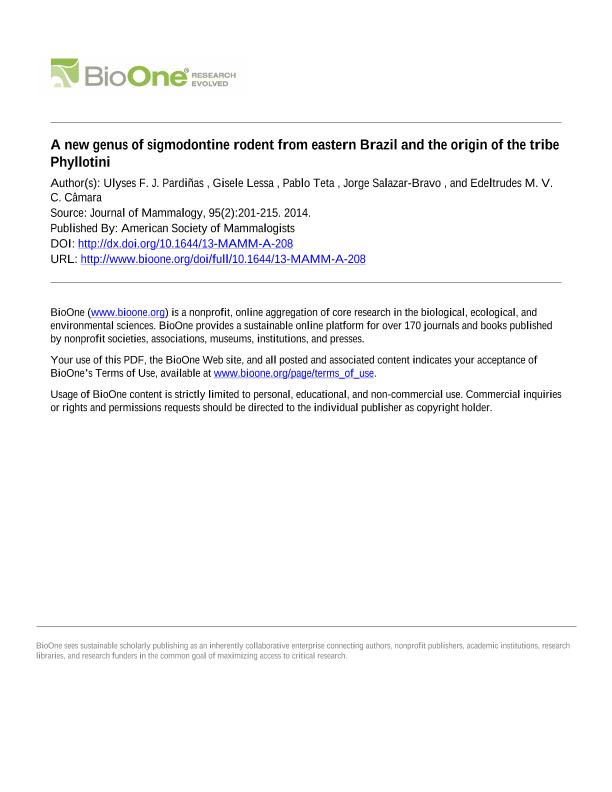Mostrar el registro sencillo del ítem
dc.contributor.author
Pardiñas, Ulises Francisco J.

dc.contributor.author
Lessa, Gisele
dc.contributor.author
Teta, Pablo Vicente

dc.contributor.author
Salazar Bravo, Jorge
dc.contributor.author
Câmara, Edeltrudes M. V. C.
dc.date.available
2017-12-06T20:15:30Z
dc.date.issued
2014-04
dc.identifier.citation
Pardiñas, Ulises Francisco J.; Lessa, Gisele; Teta, Pablo Vicente; Salazar Bravo, Jorge; Câmara, Edeltrudes M. V. C.; A new genus of sigmodontine rodent from Eastern Brazil and the origin of the tribe Phyllotini; American Society of Mammalogists; Journal of Mammalogy; 95; 2; 4-2014; 201-215
dc.identifier.issn
0022-2372
dc.identifier.uri
http://hdl.handle.net/11336/29883
dc.description.abstract
We describe a new living genus and species of Sigmodontinae currently only known from the Brazilian National Park Sempre Vivas, Minas Gerais State. This rodent is characterized by a unique combination of traits that include, among others, a long tail, with its distal tip (approximately 2.5 to 5 cm) entirely white; skull with domed profile; long rostrum with an incipient rostral tube; and noticeable small brachyodont molars with reduced mesolophs and mesostyles present on the 1st and 2nd upper molars. Cladistic analyses of molecular (1 mitochondrial and 1 nuclear marker) and morphological characters indicate that the new genus belongs to the Phyllotini and is sister to the remainder genera of this tribe. However, contrary to other known phyllotines, the new genus shows vestigial mesolophs and mesostyles. Phyllotines are widespread in open areas, in particular desert and semideserts, mostly in the western portion of South America. The new genus described herein expands the diversity of the tribe and suggests an ancient event of diversification in eastern Brazil.
dc.description.abstract
Describimos un nuevo género y especie de Sigmodontinae actualmente sólo conocido para el Parque Nacional brasilero Sempre Vivas, Estado de Minas Gerais. Este roedor se caracteriza por una combinación única de rasgos que incluyen, entre otros, una cola larga con su porción distal (ca. 2,5 a 5 cm) enteramente blanca; cráneo con perfil abovedado; rostro largo con tubo rostral incipiente; molares braquiodontos notablemente pequeños con pequeños mesolofos y mesostilos presentes en los primeros y segundos molares superiores. Análisis cladísticos de caracteres moleculares (un marcador mitocondrial y un marcador nuclear) y morfológicos indican que el nuevo género pertenece a los Phyllotini y es hermano de los restantes géneros de la tribu. Sin embargo, contrariamente a los otros filotinos conocidos, el nuevo género muestra mesolofos y mesostilos vestigiales. Los filotinos están ampliamente distribuidos en zonas abiertas, en particular en desiertos y semidesiertos, mayormente en la porción occidental de América del Sur. El nuevo género aquí descripto expande la diversidad de la tribu y sugiere un antiguo evento de diversificación en Brasil oriental.
dc.format
application/pdf
dc.language.iso
eng
dc.publisher
American Society of Mammalogists
dc.rights
info:eu-repo/semantics/openAccess
dc.rights.uri
https://creativecommons.org/licenses/by-nc-sa/2.5/ar/
dc.subject
Brazil
dc.subject
Calomys
dc.subject
Cerrado
dc.subject
Cricetidae
dc.subject
Sigmodontinae
dc.subject.classification
Otras Ciencias Biológicas

dc.subject.classification
Ciencias Biológicas

dc.subject.classification
CIENCIAS NATURALES Y EXACTAS

dc.title
A new genus of sigmodontine rodent from Eastern Brazil and the origin of the tribe Phyllotini
dc.type
info:eu-repo/semantics/article
dc.type
info:ar-repo/semantics/artículo
dc.type
info:eu-repo/semantics/publishedVersion
dc.date.updated
2017-07-27T12:31:42Z
dc.identifier.eissn
1545-1542
dc.journal.volume
95
dc.journal.number
2
dc.journal.pagination
201-215
dc.journal.pais
Estados Unidos

dc.description.fil
Fil: Pardiñas, Ulises Francisco J.. Consejo Nacional de Investigaciones Científicas y Técnicas. Centro Nacional Patagónico; Argentina
dc.description.fil
Fil: Lessa, Gisele. Universidade Federal de Viçosa; Brasil
dc.description.fil
Fil: Teta, Pablo Vicente. Consejo Nacional de Investigaciones Científicas y Técnicas. Centro Nacional Patagónico; Argentina
dc.description.fil
Fil: Salazar Bravo, Jorge. Texas Tech University; Estados Unidos
dc.description.fil
Fil: Câmara, Edeltrudes M. V. C.. Universidade Católica de Minas Gerais; Brasil. Bicho do Mato Instituto de Pesquisa; Brasil
dc.journal.title
Journal of Mammalogy

dc.relation.alternativeid
info:eu-repo/semantics/altIdentifier/doi/http://dx.doi.org/10.1644/13-MAMM-A-208
Archivos asociados
